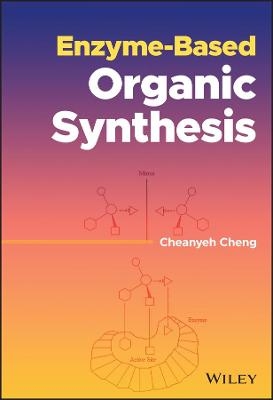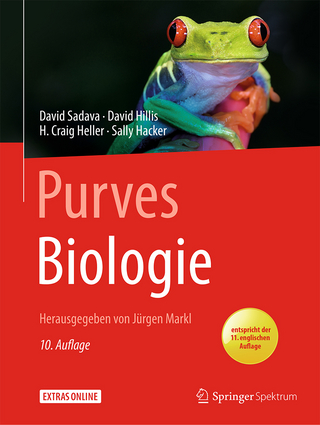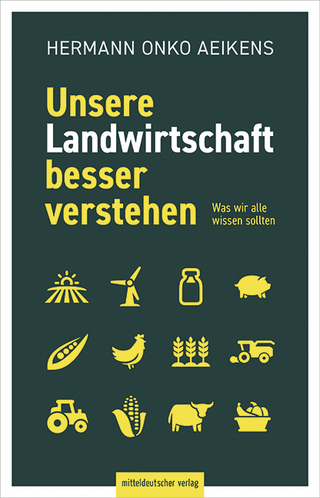
Enzyme-Based Organic Synthesis
John Wiley & Sons Inc (Verlag)
978-1-118-02794-3 (ISBN)
In Enzyme-Based Organic Synthesis, expert chemist Dr. Cheanyeh Cheng delivers a comprehensive discussion of the principles, methods, and applications of enzymatic and microbial processes for organic synthesis. The book thoroughly explores this growing area of green synthetic organic chemistry, both in the context of academic research and industrial practice.
The distinguished author provides a single point of access for enzymatic methods applicable to organic synthesis and focuses on enzyme catalyzed organic synthesis with six different classes of enzyme. This book serves as a link between enzymology and biocatalysis and serves as an invaluable reference for the growing number of organic chemists using biocatalysis.
Enzyme-Based Organic Synthesis provides readers with multiple examples of practical applications of the main enzyme classes relevant to the pharmaceutical, medical, food, cosmetics, fragrance, and health care industries.
Readers will also find:
A thorough introduction to foundational topics, including the discovery and nature of enzymes, enzyme structure, catalytic function, molecular recognition, enzyme specificity, and enzyme classes
Practical discussions of organic synthesis with oxidoreductases, including oxidation reactions and reduction reactions
Comprehensive explorations of organic synthesis with transferases, including transamination with aminotransferases and phosphorylation with kinases
In-depth examinations of organic synthesis with hydrolases, including the hydrolysis of the ester bond
Perfect for organic synthetic chemists, chemical and biochemical engineers, biotechnologists, process chemists, and enzymologists, Enzyme-Based Organic Synthesis is also an indispensable resource for practitioners in the pharmaceutical, food, cosmetics, and fragrance industries that regularly apply this type of synthesis.
Cheanyeh Cheng, PhD, obtained his doctorate from the Department of Chemical and Biochemical Engineering at Rutgers University in 1987 and is Professor of Chemistry at Chung Yuan Christian University in Taiwan. His research covers the fields of bioorganic chemistry and biotransformation, analytical chemistry, and biosensors. He owns 15 patents from Taiwan, the United States of America, Japan, and the European Union.
Preface xi
Acknowledgements xv
1 Introduction 1
1.1 Discovery and Nature of Enzyme 1
1.2 Enzyme Structure and Catalytic Function 2
1.2.1 Enzyme Structure 2
1.2.2 Catalytic Function 3
1.3 Cofactors and Coenzymes 5
1.4 Molecular Recognition and Enzyme Specificity 6
1.4.1 Substrate Specificity 7
1.4.2 Regiospecificity 9
1.4.3 Stereospecificity 10
1.5 Enzyme Classes and Nomenclature 13
1.6 Enzyme and Green Chemistry 15
1.7 The Winner of Year 2010: Greener Manufacturing of Sitagliptin Enabled by an Evolved Transaminase 17
1.8 The Winner of Year 2009: A Solvent-Free Biocatalytic Process for Cosmetic and Personal Care Ingredients 17
References 18
2 Organic Synthesis with Oxidoreductases 21
2.1 Oxidation Reactions 21
2.1.1 Oxidation of Alcohols and Aldehydes 21
2.1.2 Hydroxylation of Alkanes 26
2.1.3 Hydroxylation of Aromatic Compounds 29
2.1.4 Dihydroxylation of Aromatic Compounds 31
2.1.5 Epoxidation 35
2.1.6 Sulfoxidation Reactions 38
2.1.7 Baeyer–Villiger Reactions 39
2.1.8 Peroxidation Reactions 41
2.2 Reduction Reactions 44
2.2.1 Reduction of Aldehydes and Ketones 44
2.2.2 Reduction of C═C Bonds 50
References 55
3 Organic Synthesis with Transferases 63
3.1 Transamination with Aminotransferases 63
3.2 Glycosyl-transfer with glycosyltransferase 68
3.3 Phosphorylation with Kinases 73
3.4 Acetyl Group Transfer with Acetyltransferase 75
References 78
4 Organic Synthesis with Hydrolases 83
4.1 Hydrolysis of Ester Bond 83
4.1.1 Ester Hydrolysis with Esterases 83
4.1.2 Ester Hydrolysis with Lipases 89
4.1.3 Ester Hydrolysis with Proteases 94
4.2 Hydrolysis of Amide Bond 97
4.3 Hydrolysis of Phosphate Esters 103
4.4 Hydrolysis of Epoxides 105
4.5 Hydrolysis of Hydantoins 111
4.6 Hydrolysis of Glycosidic Bonds and Natural Polysaccharide 118
4.6.1 Hydrolysis of Starch and Applications 119
4.6.2 Hydrolysis of Cellulose and Applications 121
4.6.3 Hydrolysis of Hemicellulose and Applications 127
References 129
5 Organic Synthesis with Lyases 139
5.1 Lyases with Carbon–Carbon Bonds 139
5.1.1 Aldolases in Organic Syntheses 139
5.1.2 Enzymatic Acyloin Condensation 145
5.1.2.1 Acyloin Condensation Catalyzed by Pyruvate Decarboxylase 146
5.1.2.2 Acyloin Condensation Catalyzed by Benzoylformate Decarboxylase 147
5.1.2.3 Acyloin Condensation Catalyzed by Benzaldehyde Lyase 148
5.1.2.4 Acyloin Condensation Catalyzed by Phenylpyruvate Decarboxylase 151
5.1.3 Cyanohydrin Formation with Hydroxynitrile Lyases 152
5.2 Lyases with Carbon–Oxygen Bonds 158
5.2.1 Enzyme-Catalyzed Water Addition to Electron-Rich C=C Bonds 159
5.2.1.1 Oleate Hydratase 159
5.2.1.2 Linalool Dehydratase-Isomerase 162
5.2.1.3 Limonene Hydratase 163
5.2.2 Enzyme-Catalyzed Water Addition to Electron-Deficient C=C Bonds 164
5.2.2.1 Fumarase 164
5.2.2.2 Malease 166
5.2.2.3 Enoyl-CoA Hydratase 167
5.3 Lyases with Carbon–Nitrogen Bonds 169
5.3.1 Aspartate Ammonia Lyase 170
5.3.2 Methylaspartate Ammonia Lyase 173
5.3.3 Aromatic Amino Acid Ammonia Lyases 175
5.3.3.1 l-Arylalanines Synthesis 176
5.3.3.2 d-Arylalanines Synthesis 180
5.3.3.3 β-Arylalanines Synthesis 182
5.3.3.4 Applications for Arylalanines Synthesis 184
5.4 Lyases with Carbon–Sulfur Bonds 188
5.5 Lyases with Carbon–Halide Bonds 193
5.5.1 Synthesis of Chiral Epoxides 194
5.5.2 Synthesis of Enantiopure β-Substituted Alcohols 196
5.5.3 Application of Cascade Reactions 202
References 205
6 Organic Synthesis with Isomerases 221
6.1 Racemases and Epimerases 221
6.1.1 Amino Acid Racemases and Epimerases 221
6.1.1.1 d-Amino Acid Synthesis with PLP-Dependent Amino Acid Racemases 223
6.1.1.2 d-Amino Acid Synthesis with PLP-Independent Amino Acid Racemases 224
6.1.1.3 Amino Acid Racemases with Broad Substrate Specificity 226
6.1.1.4 Applications of Amino Acid Racemases and Epimerases 228
6.1.2 Hydroxy Acid Racemases and Epimerases 229
6.1.2.1 Lactate Racemase 229
6.1.2.2 Mandelate Racemase 230
6.1.3 N-Acetyl-d-glucosamine 2- epimerase 235
6.1.4 Hydantoin Racemase 238
6.2 Cis-Trans Isomerase 242
6.2.1 Maleate Cis-Trans Isomerase 242
6.2.2 Linoleate Isomerase 244
6.3 Intramolecular Oxidoreductases 247
6.3.1 Aldose-Ketose isomerases 247
6.3.1.1 Xylose (Glucose) Isomerase 247
6.3.1.2 l-Rhamnose Isomerase 256
6.3.1.3 l-Fucose Isomerase 261
6.4 Intramolecular Transferases 265
6.4.1 Phosphopentomutase 265
6.4.2 Lysine 2,3-Aminomutase 270
6.4.3 Lysine 5,6-Aminomutase 274
6.4.4 Tyrosine 2,3-Aminomutase 275
6.4.5 Phenylalanine Aminomutase 278
6.4.5.1 l-β-Phenylalanine Forming 278
6.4.5.2 d-β-Phenylalanine Forming 282
6.5 Intramolecular Lyases 287
6.5.1 ent-Copalyl Diphosphate Synthase 287
6.5.2 Lycopene β-Cyclase 294
References 304
7 Organic Synthesis with Ligases 321
7.1 Ligases for Carbon–Oxygen Bonds Formation 321
7.1.1 Olefin β-Lactone Synthetase 321
7.2 Ligases for Carbon–Sulfur Bonds Formation 323
7.2.1 Acetate-CoA Ligase (AMP-forming) 323
7.2.2 Medium-chain Acyl-CoA Ligase 331
7.2.3 Long-chain-fatty-acid-CoA Ligase 340
7.3 Ligases for Carbon–Nitrogen Bonds Formation 347
7.3.1 Glutamine Synthetase 347
7.3.2 l-Alanine-l-anticapsin Ligase 355
7.3.3 Carbapenam-3-carboxylate Synthase 359
7.4 Ligases for Carbon–Carbon Bonds Formation 363
7.4.1 Pyruvate Carboxylase 363
7.4.2 Acetyl-CoA Carboxylase 383
References 414
8 Future Perspectives 431
8.1 Combinatorial Enzymatic Organic Synthesis 431
8.1.1 Combinatorial Chemistry 431
8.1.2 Principle of Combinatorial Chemistry 432
8.1.3 Combinatorial Chemistry with Enzymes 433
8.1.3.1 Enzymes as a Tool in Combinatorial Synthesis 434
8.1.3.2 Combinatorial Biocatalysis 437
8.1.3.3 Combinatorial Biosynthesis 445
8.2 Artificial Intelligence Assisted Enzymatic Organic Synthesis 452
8.2.1 Introduction to Artificial Intelligence 452
8.2.2 Categorization of Artificial Intelligence 453
8.2.3 Machine Learning 454
8.2.4 Artificial Intelligence with Enzymatic Organic Synthesis 455
References 460
Index 465
| Erscheinungsdatum | 03.10.2019 |
|---|---|
| Verlagsort | New York |
| Sprache | englisch |
| Maße | 10 x 10 mm |
| Gewicht | 454 g |
| Themenwelt | Naturwissenschaften ► Biologie |
| Naturwissenschaften ► Chemie | |
| ISBN-10 | 1-118-02794-9 / 1118027949 |
| ISBN-13 | 978-1-118-02794-3 / 9781118027943 |
| Zustand | Neuware |
| Informationen gemäß Produktsicherheitsverordnung (GPSR) | |
| Haben Sie eine Frage zum Produkt? |
aus dem Bereich


